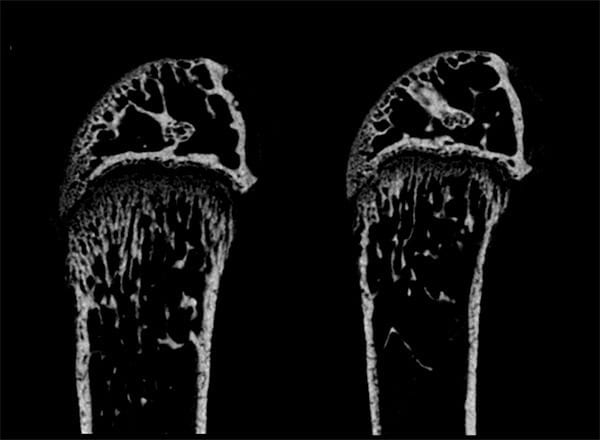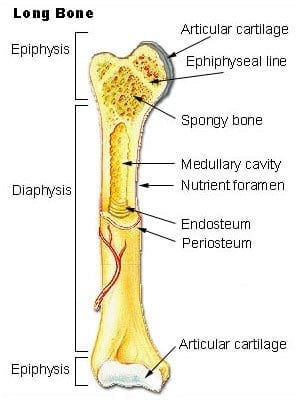
Researchers identify a treatment for a rare bone loss disorder that might also lead to help for aging brittle bones
A possible ‘first-line’ treatment for a rare bone loss disease has been identified by a research team led by Tohoku University in Japan. The research findings, published in the journal Molecular Cell, could also provide insight into treating age-related osteoporosis.
Hajdu-Cheney syndrome is a rare genetic disease that leads to severe osteoporosis and developmental defects, including the reabsorption of bones in the hands and feet. The disease is associated with mutations in a particular gene, called NOTCH2, which codes for proteins involved with bone maintenance. The NOTCH2 proteins usually help balance destruction and construction essential for bone maintenance and repair. Mutations associated with Hajdu-Cheney syndrome upset that balance, but the exact mechanisms causing bone resorption have not been well understood.
Now, through a series of detailed tests, molecular biologist Hiroyuki Inuzuka and his colleagues have worked out the specific molecular pathway that results in Hajdu-Cheney syndrome.
They found that this particular NOTCH2 mutation does not maintain normal NOTCH2 protein abundance, with the help of another protein, called FBW7. To discover this, the researchers knocked out the gene for Fbw7 in the bones of mice. Without the gene and resulting protein, the mice had severe osteoporosis, much like people with Hajdu-Cheney syndrome — indicating that FBW7 is the primary regulator of this system.
They further determined that in humans with Hajdu-Cheney syndrome, the FBW7 protein was unable to bind to NOTCH2 proteins because the binding spot is missing in osteoclasts. This mutation allows the osteoclasts to over-operate, breaking down too much bone tissue.
The researchers were able to reverse bone loss in the knock-out mice with the elevated NOTCH2 by giving them a medication that blocks osteoclast formation. They tried several different treatments, including a chemical compound called DAPT that was particularly effective. DAPT has been shown to help with osteoarthritis by inhibiting function of NOTCH proteins in other studies. Using DAPT as well as Zoledronic acid, a common medication for osteoporosis, “may become a first-line treatment for Hadju-Cheney syndrome,” the researchers conclude in their study.
“By clearly identifying the relationship between FBW7 and NOTCH2 proteins, we have identified potential therapeutic targets for patients with rare bone diseases as well as much more widespread age-related osteoporosis,” said Inuzuka.
Learn more: Reversing severe bone loss
The Latest on: Bone loss
[google_news title=”” keyword=”bone loss” num_posts=”10″ blurb_length=”0″ show_thumb=”left”]
via Google News
The Latest on: Bone loss
- Cancer-Treatment-Induced Bone Loss, Part 1on May 3, 2024 at 5:01 pm
Am J Health Syst Pharm. 2006;63(5):419-430. During resorption, growth factors and proteins released from osteoblast precursors and bone stimulate the differentiation, chemotaxis, and proliferation ...
- Not practicing proper oral hygiene can lead to bone losson April 29, 2024 at 5:00 pm
Bone loss in the mouth is a serious condition that can lead to a host of dental and health problems, including the loosening or loss of teeth. Often overlooked, the root causes of bone loss extend ...
- Top 8 Best Bone Builder Supplements in 2024on April 27, 2024 at 5:00 pm
reduce the rate of bone loss, and even help protect your cardiovascular health. Some users may experience side effects such as constipation or stomach upset. This supplement may not be suitable ...
- Bone Broth Drinks Can Heal Your Gut to Boost Weight Loss: Top Doc Shares 3 Recipeson April 25, 2024 at 11:17 am
The same thing has happened to bone broth… the food that is now being lauded as “liquid gold” for its ability to repair a damaged gut, speed weight loss and transform our health. Talk about an unsung ...
- Cancer-Treatment-Induced Bone Loss, Part 2on April 24, 2024 at 5:00 pm
and modifying behaviors that increase the risk of bone loss. Clinical trials evaluating these interventions in patients with cancer have not yet been conducted; thus, the recommendation for these ...
- Zoledronic acid prevents bone loss in early-stage breast canceron February 5, 2024 at 7:21 pm
The women treated with hormonal therapy during the study experienced very rapid loss of BMD at the lumbar spine (reduced by 11.3%), and at the hip (reduced by 7.3%). Bone loss was completely ...
- A meta-analysis of impact exercise on postmenopausal bone loss: the case for mixed loading exercise programmeson January 3, 2024 at 9:58 am
Objectives: To assess the effects of differing impact exercise protocols on postmenopausal bone loss at the hip and spine. Design: Systematic review and meta-analysis. Data sources: Electronic ...
- How Osteoporosis Self-Care Slows Bone Losson December 20, 2023 at 3:44 pm
Leading a healthy lifestyle on a daily basis can help slow the rate of bone loss in addition to decreasing the risk of developing cardiovascular disease, diabetes, and many other common health ...
- Bone loss, osteoporosis, and HIVon December 5, 2023 at 11:58 am
If the amount of new bone being made doesn’t keep up with the loss of old bone, your bones become less dense and lose some of their strength. Following a minor trip or fall, the bones may be more ...
via Bing News










